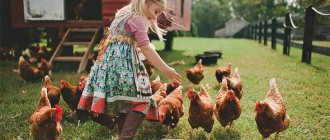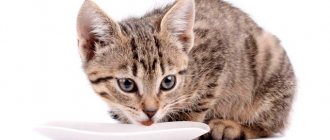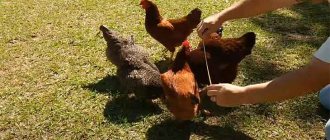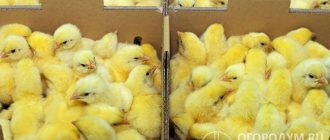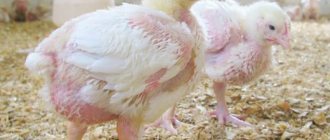The main goal of keeping egg-laying hens is to produce large quantities of large, edible eggs. In order to increase egg production, you need to know what to feed laying hens, how and how many times a day to do it, and whether you can give them scraps from your table.
For food, birds use grain, vegetables, fruits, mixed feed, grass, fish/meat, and sour milk.
There are also many additives for better egg production. These include both natural products (chalk, shell, meat and fish meal, fish oil, etc.), and special premixes and vitamin-mineral mixtures (which are sold separately and are also included in the premixes).
General feeding recommendations
Excess and lack of feed in the diet of laying hens equally negatively affects egg production. Excessive feeding causes the bird to gain excess weight. Overweight chickens lay eggs poorly or not at all. Eggs from such individuals, as a rule, are unfertilized.
It is especially important to provide adequate and high-quality feeding to laying hens in the spring, from which the hatching eggs are obtained. Poor nutrition leads to a decrease in egg production, weak young animals and poor hatchability.
Feeding time also plays a big role in egg production. It has been proven that laying hens that receive feed at strictly defined hours lay eggs more often.
With the onset of cold weather, birds need nutrients more. Therefore, it is necessary to feed chickens up to 3 times a day in winter. In the summer, when laying hens receive a lot of succulent green food, the birds are transferred to two meals a day.
In autumn and spring, the bird begins to molt. During this period, chickens also need to be provided with a large amount of feed with increased nutritional value.
After waking up in the morning, the chickens are immediately fed. The first feeding usually consists of a wet mash with the addition of vegetables, grains and bran.
In the evening, feed is given about an hour before the birds enter the chicken coop. Laying hens should receive grain crops for dinner. From time to time it is recommended to alternate different types of grain. It is not recommended to mix them, as the bird will only peck what it likes best.
The diet for feeding laying hens at home is compiled depending on productivity, breed and age. For example, young future laying hens are provided with feed high in protein and calcium during the pre-laying period. At 50% egg-laying intensity, pullets should receive 105-110 feed mixtures per day. At peak egg production, hens are fed ad libitum.
In the second year of life, egg production of chickens decreases. During this period, it is more advisable to reduce the feed supply by 7-10%. Limiting feeding within these parameters does not negatively affect productivity, but allows significant savings on feed.
In the diet of adult laying hens over a year old, reduce the amount of protein and increase calcium intake by 10-15%.
When drawing up feeding standards, the body weight of the bird must also be taken into account. Laying hens weighing 1.8 kg per day should receive 120-125 g of feed per head. With a weight of 2 kg, the daily ration is increased to 130 g. Next, feed consumption per hen is calculated according to the following scheme: plus 10 g for every 250 g of weight.
Chickens whose diet is based on whole grains must receive gravel. It promotes better digestion of feed and absorption of nutrients.
At what age should chickens start laying eggs?
Physiological processes in a bird that prepare it for a special role begin at the moment when the chick hatches from the egg. A chicken reaches sexual maturity in four to five months; as a rule, at this time the bird reaches 75 percent of its possible weight. It is of great importance when the chick was born. Practicing poultry farmers say that spring chickens are much more profitable, because these laying hens begin to lay eggs in the summer. If the chicks hatched in June-August, then the hens will lay eggs only the next year, after winter.
According to the types of chickens, they are divided into egg, meat, and egg-meat. It has been proven that egg-laying chickens begin to lay eggs after five or even four months. These birds are not large in size, weighing up to three kilograms, but their productivity is high. By the way, they lay well for three years.
It is useless to expect good laying from meat chickens. These individuals begin to lay eggs only after six months. These are large chickens, sometimes weighing five kilograms. Good egg production lasts eight months at most.
Birds producing eggs and meat are small, gaining weight up to three and a half kilograms. Laying hens lay eggs well, the first laying is usually done after five months, that is, approximately 20 weeks from hatching, and remain productive for up to two years.
In principle, any chicken can lay eggs throughout its entire life, that is, all fifteen years. However, only the first years are considered productive, then egg production fades away. It becomes unprofitable to keep chickens longer than three years.
Types of feed
Poultry farmers either use ready-made feed or create their own diet. Each type of feeding has its pros and cons. The poultry farmer decides what is best to feed the chickens based on his financial and labor costs. From an economic point of view, compound feed is cheaper than home-made feed mixtures with the addition of feed additives.
Based on the structure of the feed, they are divided into dry, wet and combined. Dry types include grain crops and industrial feed. The wet category includes mash with vegetables and the addition of bran. The combined type of feeding involves mash with the addition of grain and feed additives.
Chickens, regardless of the type of food they eat, should always have clean drinking water freely available.
Is it possible to feed chickens food that humans eat?
- If the owner constantly diversifies the menu for his birds, then he will collect a lot of eggs. You can also add variety using waste from the human table.
- Of course, not everyone can feed chickens (read about prohibited foods below). The main nutrition can be safely replenished without compromising chicken health with pasta, cereals, dried cotton products, vegetable and fruit peelings, tops, fish heads and offal, meat and bone residues.
- You can also use broths, both meat and fish, and sour milk for the mash.
Cereals
The basis of the chickens' diet is grain. It provides the bird with sufficient energy and a feeling of satiety. From grain crops, laying hens should be given:
- corn;
- wheat;
- barley;
- rye;
- oats
Chickens love corn. It is easily digestible and serves as the main source of energy for poultry. The grain is given only in ground form.
When kept in cages, laying hens can be fed corn only occasionally. This also applies to meat-eating breeds (Australorp, Wyandot, Master Gray, Foxy Chick, etc.). Frequent feeding of corn to such chickens leads to rapid weight gain and decreased egg production.
Wheat can be the main feed for laying hens (up to 60% of the total daily ration). It is valued for its high protein content, vitamins B and E.
Rye also contains a lot of protein, but the crop should not often be fed to poultry. This product contains many non-starch polysaccharides, which leads to the viscosity of the intestinal contents and the formation of sticky droppings. The daily norm of rye is no more than 20 g per day per individual.
Barley contains a lot of carbohydrates and slightly less protein than wheat. Culture can make up from 40% to 60% of the total daily ration. It is preferable to give this type of grain to laying hens in crushed or sprouted form.
Oats contain a lot of indigestible plant fiber and fat. This grain is especially useful during the molting period of chickens. Oats accelerate the process of growing new feathers and reduce the risk of cannibalism in the herd.
Occasionally, triticale can be used in feeding chickens. The cereal crop is a hybrid of wheat and rye. But as the practice of poultry farmers shows, chickens do not eat triticale very willingly.
During the period of intensive egg laying and in winter, it is recommended to feed part of the grain to laying hens in sprouted form.
Drinking regime of laying hens
Chickens have vital access to drinking water. Depriving the bird of drink for 2-4 days will lead to a complete cessation of egg laying. On average, one laying hen weighing about 1.75-2 kilograms drinks 235-250 ml of liquid per day.
Watering is provided in several ways. The simplest is a bowl or pan with water. In this case, it is necessary to renew the fluid throughout the day, as it may become contaminated. Chickens also often knock over containers.
A more modern way is to use nipple or vacuum drinkers. In this case, the water remains clean. But remember that the drinking bowls must be periodically washed to remove mucus, greens, etc.
Herbs
In addition to grain, the diet of laying hens must include herbs. Juicy green feed is the main source of vitamins for poultry in the summer. In winter, herbs can be dried. When properly dried, greens practically do not lose their beneficial substances.
In summer, succulent green food should make up approximately 30% of the total diet.
Of the herbs, dandelion, alfalfa, clover, and nettle are especially useful for chickens. Juicy green food can be given fresh or crushed in mash. In the summer, free-range chickens provide themselves with succulent green feed in the required quantities.
Herbs not only increase egg production, but also improve the taste of eggs and make the yolk a richer orange color.
Reasons for decreased egg production
There are a huge number of factors that influence loss of productivity. The most compelling reason is poor nutrition, which results in soft-shelled eggs that can be eaten by chickens. In this case, the owner needs to completely reconsider the feeding method of his livestock.
This problem most often occurs in young animals due to a lack of minerals. For good egg production, feed must be saturated with calcium, phosphorus, and the necessary vitamin supplements.
Vegetables
Chickens eat well boiled potatoes, carrots, beets, cabbage leaves, and Jerusalem artichoke as vegetables. Typically, these crops are fed to laying hens in crushed form, adding to wet mash.
During the molting period, it is useful to give the bird more white cabbage. The vegetable contains a lot of sulfur, which is necessary for the formation of a new feather. Cabbage leaves can be fed to chickens in their pure, whole form, hanging in the chicken coop.
It is important not to overfeed the bird with vegetables, since their excess in the diet often provokes diarrhea.
Feed additives
Feeding laying hens to lay eggs better is not enough with just grains and vegetables. The diet of egg poultry must be enriched with feed additives.
Calcium, phosphorus and vitamin D are especially important during the period of intensive egg laying for laying hens. Very little of these elements are contained in grains and vegetables. Therefore, eggshells, chalk, shell rock, slaked lime (sources of calcium and phosphorus), tricalcium phosphate, bran (contain phosphorus), and fish oil (source of vitamin D) must be included in chicken feeding.
A laying hen is given 6 to 8 g of feed chalk, eggshells or shells per day. Feed tricalcium phosphate is given at a dosage of 8 g per bird. The daily rate of fish oil is 1 ml per 10 heads.
We must not forget about feed yeast. The supplement contains many B vitamins, which increase egg production, and a large amount of phosphorus. For adult laying hens, the daily yeast requirement is 3-5 g per head.
Amino acids play a special role in good egg production, the main source of which is animal products (meat and bone meal and fish meal). Birds are fed 7-8 g per day per bird.
In order for chickens to lay eggs well, it is also important to add linoleic acid to the feed. There is a lot of it in sunflower cake and soybean meal.
Additionally, laying hens need sodium and chlorine. At home, chickens can obtain these elements from ordinary table salt. It improves the digestibility of food and increases the bird's appetite. It is important to give salt to chickens correctly and in limited quantities. Excess sodium chloride in the diet can lead to poisoning of laying hens.
To increase the nutritional value of feed and increase egg production, it is useful to give premixes to chickens (Ryabushka, Zdravur Laying, etc.). Such supplements are already enriched with the necessary amount of vitamins, amino acids and minerals.
How to feed chickens so they lay eggs every day
To increase the egg production of birds, it is necessary to add liquid vitamins to the drinking water. Most often it is iron and calcium. Experienced poultry farmers add Chiktonik to the water. It contains all the necessary vitamins and minerals. Dilute it according to the instructions and water the chickens for 5 days.
Picture 8 Drink for chickens to increase egg production
Important! Frequent use of Chiktonik may be harmful. The interval between sessions should be at least 2 months.
You can also feed chickens with fish oil diluted with water.
Ready-made feed
Some poultry farmers, to save time, effort, and also reduce financial costs, purchase ready-made combined feed for laying hens. As a rule, it contains a grain mixture of wheat and corn, sunflower or soybean meal, bone meal, phosphates and feed yeast. Additionally, industrial feed for laying hens is enriched with calcium, amino acids and vitamins.
Popular brands that produce chicken feed include Bogdanovich, Yuzhnaya Korona, Best, Purina.
High-quality industrial feed for laying hens does not require the introduction of other food products into the poultry’s diet and increases egg production by 2 times. At the same time, poultry farmers note that egg laying in young chickens occurs faster, and the egg becomes larger and its taste improves.
When choosing feed, it is important to pay attention to its structure: it should be uniform. This will prevent birds from selectively eating the feed.
The feeding rate is 120 g per day for chickens weighing from 1.5 to 1.8 kg. With a weight of 2 kg and above, the amount of feed is increased to 140-150 g.
Making mash
At home, to reduce feed costs and enrich the diet with important nutrients, poultry farmers practice preparing mash for chickens. They are based on vegetables, bran and grains. You can also occasionally add apples and berries to the feed mixture.
It is advisable to add vegetables (except potatoes) fresh. It is recommended to pre-grind or steam the grain for preparing wet food.
It is most convenient to add feed additives to mash. Meat and bone or fish meal, sunflower cake or vegetable oil, chalk, shell or eggshell, fish oil, and salt are added to the wet food.
Up to 2 times a week with mash it is useful to give minced meat and bones or fish, or sprouted grains.
Approximate recipe for mash for 10 chickens:
- 500 g of vegetables (potatoes, pumpkin, carrots, etc.);
- 450 g whole grains;
- 50 gr. crushed corn;
- 100 g sunflower cake;
- 70 g meat and bone meal;
- 30 gr. feed chalk or eggshells;
- 4 ml fish oil;
- 3 g salt.
Up to 2 times a week, mash can be prepared using broth made from meat scraps and bones. It is also useful to add fermented milk products from time to time: kefir, yogurt, whey (100-200 ml per 10 heads).
In winter, the percentage of grain in wet food is increased. A winter version of a mash for 10 laying hens may look like this:
- 600 gr. grains;
- 100 gr. wheat bran;
- 500 gr. vegetables;
- 100 gr. cake;
- 100 gr. kefir or yogurt;
- 30 gr. eggshells or shells;
- 80 gr. meat and bone meal;
- 4 ml fish oil;
- 3 g salt.
In winter, onions, sprouted grains, and unsalted lard are added to the mash up to 2 times a week.
What is forbidden to give to chickens
Despite the fact that chickens are unpretentious birds, they are picky about feed, they need to be given only healthy food in order to get high-quality products, be it meat or eggs.
Green potatoes with sprouts
It is in this form that root vegetables pose a serious danger to laying hens, and the same applies to the water in which cooking took place. Green potatoes contain excess solanine, which can lead to poisoning of livestock.
Bakery products
Dried white bread can be given to chickens in small quantities, but black bread has high acidity, which can disrupt the functioning of the digestive system. The result is diarrhea. Sweet pastries cause fermentation in the stomach and have a negative effect on the circulatory system.
Sausages
You should not give laying hens any type of sausage or frankfurters. Such products contain excess fat, seasonings, chemical flavors, dyes and preservatives. All these components can cause a heart attack or stroke in a bird.
Cheeses and milk
The body of laying hens does not produce the enzyme involved in the processing of lactose. Milk and cheese entering the stomach of birds lead to dysbacteriosis, and cheeses also contain salt and fat. What an excess of such components leads to has already been discussed.
First meal
For many poultry farmers, it is common practice to feed birds with table waste. Porridge and vegetable salads will not cause much harm, unlike soups. Most broths, with the exception of the vegetarian version, are prepared with a fatty base, which is very harmful to chickens.
Sweet products
Poultry's pancreas produces insulin, but not in sufficient quantities to combat the high sugar content of baked goods. An excess of this component will become a favorable environment for the development of pathogenic fungus.
Alcohol
An exception can be made only for medicines with an alcohol base; they must be diluted with water before use. Such medications are used for treatment for no more than 7 days. A longer period causes irreversible processes in the liver of chickens, which is not able to process alcohol.
Yeasting of feed
In order for chickens to lay eggs well, it is important to ferment the feed from time to time. This has a positive effect not only on productivity, but also on the health of the bird in general. Yeast for chickens is a source of B vitamins and amino acids. Recipe for making feed yeast:
- crushed wheat – 0.5 kg;
- crushed oats and barley – 0.2 kg each;
- crushed corn – 0.1 kg;
- feed yeast – 2 tbsp. l.
The yeast is pre-dissolved in a glass of warm water (from +40 to +45 degrees). The resulting concentrate is diluted with 1.5 liters of warm water and the prepared grain mixture is poured. All ingredients are thoroughly mixed and put in a warm place for 7-8 hours for yeasting.
The consumption rate of such food is 20 g per individual per day. Duration of use – from 5 to 7 days. Yeasting is recommended to be carried out throughout the entire autumn-winter period every 1-2 weeks.
Sprouting grain
To ensure that chickens continue to lay eggs in winter, sprouted grains must be added to the diet. Cereal sprouts contain many vitamins A, B, D, E, minerals and trace elements.
Wheat, barley, rye, and oats are suitable for germination. You can also use a mixture of grains.
The grain mixture is poured with warm water at a temperature of approximately 40 degrees. Place in a warm place to swell for 10 hours. Then the water is drained and the grain is laid out in a layer 3-4 cm thick on oilcloth. Cover the top with a damp cloth. As the material dries, it is moistened with water. After 1-2 days, sprouts appear and the grain is ready for consumption. One laying hen can be given up to 30 grams per day. such food.
It is recommended to feed sprouted grain to chickens in winter 2 to 3 times a week.
Feeding rates depending on the season
Feeding laying hens at home should take into account the time of year. The need for one or another element may increase or, conversely, decrease depending on the season. The table below shows seasonal feeding rates in grams per hen per day.
| Type of feed/feed additive | Spring | Summer | Autumn | Winter |
| Whole grains | 45 | 45 | 45 | 55-60 |
| Crushed | 55 | 60 | 55 | 50 |
| Sunflower cake or soybean meal | 13 | 12 | 12 | 12 |
| Potatoes (boiled) | 40 | 20 | 20 | 50 |
| Carrot | 40 | 0 | 20 | 40 |
| Grass/hay | 40 | 60 | 40 | 40 |
| Wheat bran | 10 | 10 | 10 | 10 |
| Meat and bone meal | 8 | 6 | 7 | 6 |
| Shell or chalk | 6 | 8 | 5 | 5 |
| Dairy products | 30 | 30 | 20 | 20 |
| Yeast | 5 | 3 | 3 | 3 |
| Fish fat | ||||
| Salt | 0.7 | 0.5 | 0.5 | 0.7 |
Bird feeders
You can make so-called bunker feeders for chickens based on a sewer pipe. It will be quite cheap, but the animals will have regular access to their food, and they will not be able to dig up food. a feeder of this type must be protected from above in the form of a canopy to protect the food from rainwater. You can also make your own drinking bowls on a similar basis.
If you understand the needs of animals at a sufficient level, then any desire to engage in this business will disappear and, in general, it will be easier to buy store-bought eggs. However, in reality, everything is not as complicated as it might seem. Laying hens are characterized by independent regulation, and therefore it is enough just not to overdo it with the dosage of one or another component per day and the bird’s body will independently bring the indicator to the desired level.
In addition, to feed the bird, you can resort to nutrition such as pelleted feed. Using it automatically can be cheaper than making healthy mash yourself. The composition and price of feed mixtures are different. The cost depends on many factors. If you follow proper care, you will raise healthy and active birds. It is better to give leftover food to other animals if they eat it, for example for a cat or dog. Cats can be fed many foods without harm to their health.
